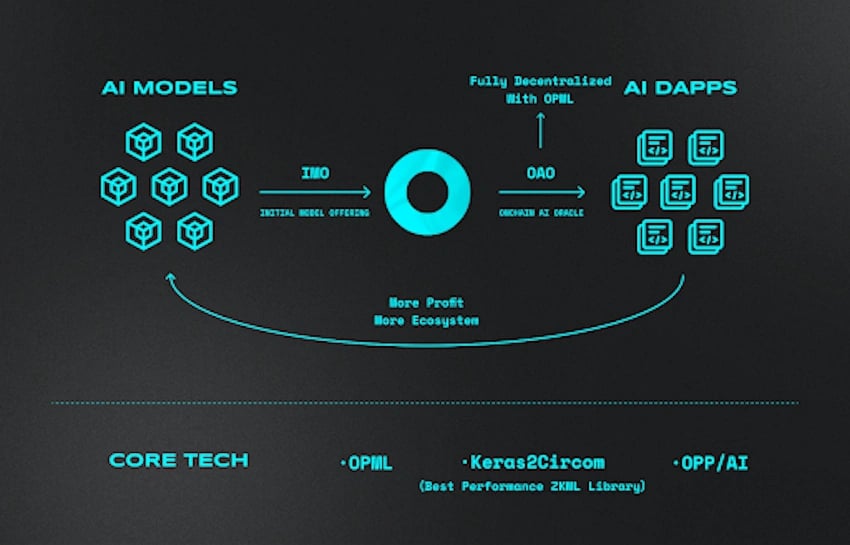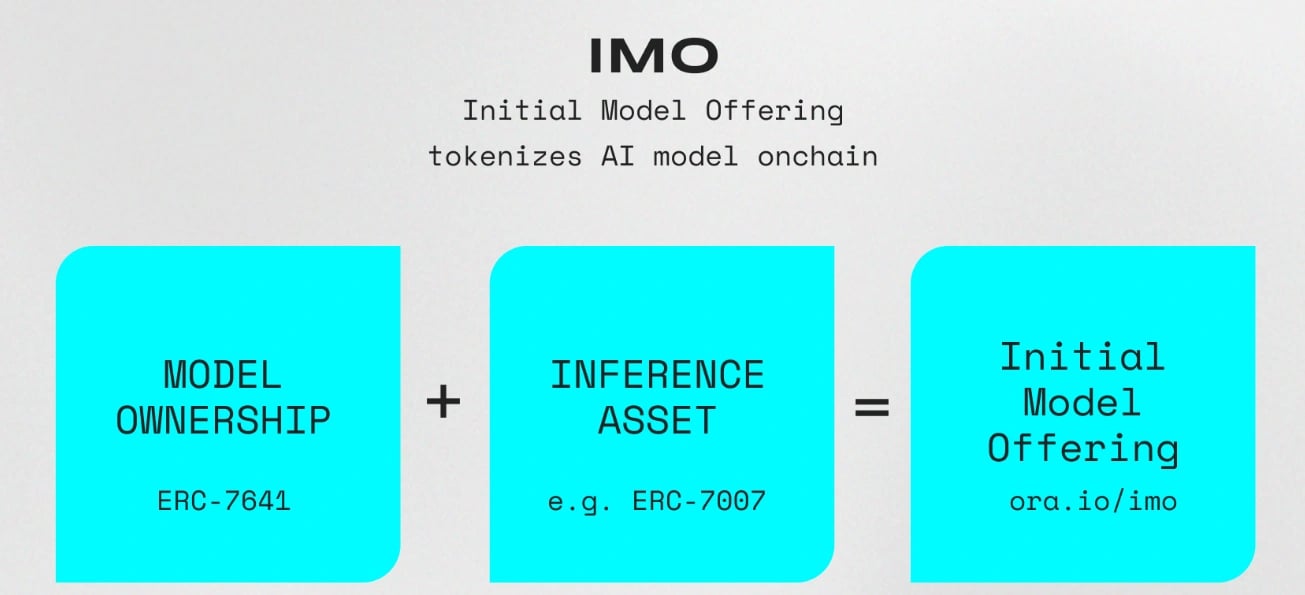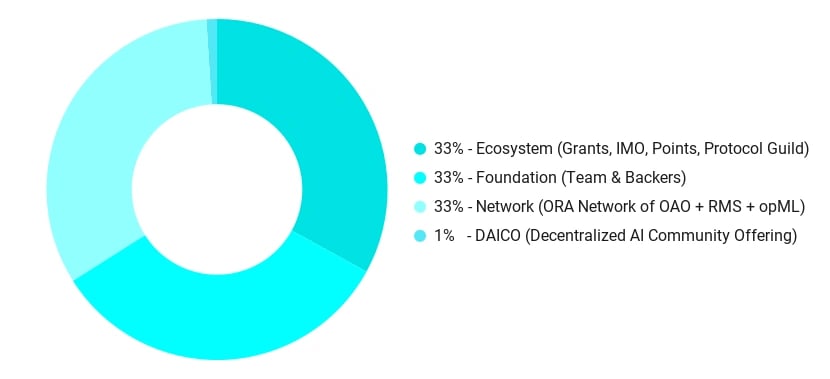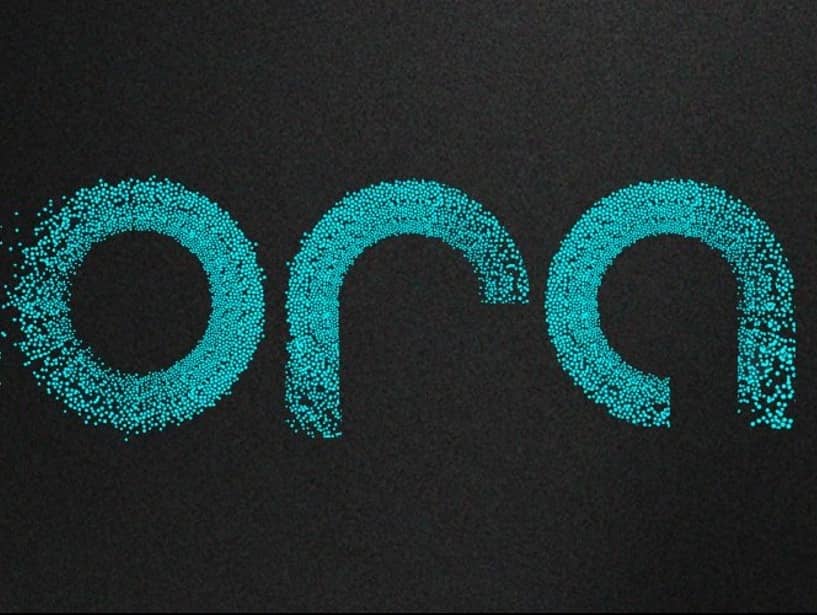ORA Protocol
Ora协议是一个可验证的预言机协议,它将人工智能和复杂的计算引入链上。它由Kartin Wong于2022年9月共同创立。[1][2]
概述
Ora协议为将区块链与去中心化应用集成提供区块链无关的基础设施。它为开发者提供了直接在链上运行和验证AI计算的工具,旨在创建既无需信任又去中心化的系统。该协议专注于在区块链环境中实现可扩展、可验证的AI。其主要服务AI Oracle允许智能合约通过使用TORA客户端的去中心化节点网络访问AI功能。该系统由乐观机器学习(opML)支持,以确保计算完整性。Ora还引入了初始模型发行(IMO),这是一种使用ERC-7641对AI模型进行代币化的方法。这种方法支持开源AI开发的资金,并将收入分配给与在去中心化应用中使用这些模型相关的代币持有者。 [3]
产品
Onchain AI Oracle (OAO)
Ora Protocol的链上AI预言机是一个可验证的预言机系统,旨在将机器学习推理引入区块链。它使智能合约和去中心化应用程序能够访问和验证来自高级AI模型(如LLaMA 3和Stable Diffusion)的输出。
该系统由乐观机器学习(opML)驱动,该技术使用欺诈证明来验证计算并确保无需信任的执行。与零知识机器学习(zkML)相比,这种方法降低了计算成本并提高了可扩展性。
AI预言机由智能合约和链下组件组成。_opML合约_管理欺诈证明和可验证性,而_AIOracle合约_促进链下ML节点和链上调用者之间的交互。_用户合约_发送AI请求并接收结果。运行TORA客户端的ORA节点负责提交和验证整个网络的推理结果。 [4]

乐观机器学习 (opML)
opML(乐观机器学习)是一个框架,可以在区块链网络上实现可扩展且高效的机器学习推理。它允许先进的 AI 模型在去中心化环境中运行,而不会使区块链过载或依赖中心化系统。受到乐观rollup的启发,opML 假设 ML 计算是有效的,除非受到质疑,从而显著减少了对链上即时验证的需求,并使复杂的 AI 应用在链上更实用。
该系统通过链下执行 ML 任务来实现其效率,只有有争议的结果才进行链上验证。这是通过欺诈证明机制完成的:结果由服务提供商提交,验证者有一段设定的时间来质疑它们。如果发生争议,系统会识别出确切的计算步骤,并仅使用欺诈证明虚拟机 (FPVM) 验证该步骤。这种方法在确保准确性和完整性的同时,保留了计算资源。
与零知识机器学习 (zkML) 相比,opML 避免了生成证明的高成本,使其成为去中心化 AI 更容易获得的解决方案。它通过保持验证的开放性和可验证性来实现去中心化,而无需中心化监督。opML 通过 ORA 的 AI Oracle 提供,为开发人员提供了将可靠且经济高效的 AI 功能直接集成到智能合约和区块链应用程序中的基础设施。[16]
Optimistic Privacy-Preserving AI
opp/ai (Optimistic Privacy-Preserving AI) 是一个框架,旨在通过结合两种现有方法的特性:零知识 机器学习 (zkML) 和乐观机器学习 (opML),支持链上机器学习中的隐私和效率。它允许根据敏感性将机器学习模型划分为多个组件,对需要数据保密性的计算使用 zkML,对速度和成本效益更重要的不太敏感的流程使用 opML。
该系统通过将模型划分为两个部分来工作。第一部分 M_zk 包含涉及敏感数据或专有算法的子模型,并使用零知识证明进行处理,以确保这些数据的私密性。第二部分 M_op 包含不涉及隐私问题的子模型,并使用 opML 的乐观方法在链下执行,该方法假定正确性,除非提出质疑。这种结构使 opp/ai 能够减少通常与完整 zkML 系统相关的计算开销。
在执行期间,zkML 子模型的输出可以馈送到 opML 子模型,反之亦然,从而实现集成的工作流程。zkML 部分将零知识证明提交到区块链进行验证,而 opML 部分则依赖于挑战-响应模型来确认结果的准确性。通过混合这些方法,opp/ai 支持在区块链网络上灵活、安全和高效地部署 AI 模型。 [17]
弹性模型服务 (RMS)
弹性模型服务 (RMS) 是一种 AI 基础设施,旨在支持各种区块链场景中可靠且安全的机器学习计算。RMS 建立在 ORA 的 opML(乐观机器学习)框架之上,旨在确保 AI 流程保持稳定、容错和可验证。RMS 的初始阶段包括 ORA 的 AI API,使开发人员能够在去中心化、可验证的环境中访问常用的 AI 模型,用于聊天完成和图像生成等任务。
RMS 支持开发能够在链上透明运行的自主 AI 代理。这些代理可以安全地执行任务,并具有链上可验证性,使其适用于需要高度信任和透明度的应用程序。此外,RMS 促进了 AI 与 去中心化金融 (DeFi) 协议的集成,为在链上系统中实施自动化交易、风险评估和基于 AI 的金融代理提供工具。
Web3 游戏也受益于 RMS,它能够为响应式游戏机制、角色互动和实时决策提供 AI。通过区块链对 AI 结果的验证,RMS 有助于维护游戏玩法的公平性和透明度。RMS 的基础 opML 提供可扩展、高效和去中心化的 AI 计算,同时在所有支持的用例中保持透明度和可信度。[18]
首次模型发行(IMO)

首次模型发行(IMO)是一种旨在通过将AI模型在链上代币化来支持AI模型开源开发的机制。这种方法旨在解决开源AI社区的开发者面临的财务可持续性问题,该社区目前面临着来自占主导地位的闭源公司的压力。通过将AI模型转化为代币化资产,IMO创建了一个系统,使开发和使用更加透明、协作和财务可行。
IMO发行ERC-7641代币,称为内在收益分成代币,代表AI模型未来价值的所有权。这些代币使持有者有权分享AI模型用于推理或内容生成时产生的费用。这种结构协调了开发者、用户和贡献者之间的激励,使每个群体都可以参与模型生态系统的增长和治理。
IMO流程包括模型的代币化,然后通过链上使用创造价值,并将产生的费用分配给代币持有者。治理功能允许代币持有者影响模型的发展方向,例如投票决定赠款分配和未来更新,从而加强了社区驱动的AI模型演进方法。 [5] [6]
IMO 机制
初始模型发行(IMO)机制围绕两个核心组件构建:可验证的链上AI模型和ERC-7641内在收益分成代币。这种结构旨在创建一个自给自足的经济循环,其中AI模型在区块链上的使用通过标准化的代币系统直接产生和分配价值。
- 可验证的链上AI模型通过opML实现,opML是一个应用欺诈证明以高效且可扩展地验证机器学习计算的框架。这些模型通过ORA的AI Oracle部署,ORA的AI Oracle作为基础设施,使AI推理能够在链上执行和验证。这种设置确保每次使用模型的输出时(例如通过智能合约),都会发生可验证的交互,从而可以触发收入捕获。
- ERC-7641代币通过将模型使用与基于代币的奖励联系起来,促进了这种收入分配。每当AI模型在链上使用时,都会收取费用并按比例分配给代币持有者。此外,如果模型产生具有版税或铸造费用的内容(例如NFT),则可以使用相关标准(如ERC-7007)分配这些收入。这种设计支持可持续发展和AI模型经济生态系统中的去中心化参与。[5]
ERC-7641
ERC-7641是ERC-20代币标准的扩展。它集成了内置的收益分享机制,使持有者能够在指定的快照间隔根据其代币余额按比例分享公共收入池。它通过允许项目代币化收入流并在参与者之间公平分配收入来支持可持续融资。该标准还包括一个销毁功能,持有者可以销毁他们的代币以换取池价值的一部分,引入通货紧缩经济,减少供应并激励长期参与。 [19]
ERC-7007
ERC-7007是ERC-721 NFT标准的扩展,旨在表示和验证以太坊 区块链上的AI生成内容。它使NFT能够验证AI生成的内容,确保其由特定模型使用给定的输入生成。该标准集成了零知识机器学习(zkML)和乐观机器学习(opML)来验证内容的正确性。通过提供一种验证AI生成内容并将其货币化的方法,ERC-7007支持AI模型作者和内容创作者,提供了一种安全且标准化的方法,通过可验证的NFT促进收入分成。它包括AI模型、zkML/opML验证以及符合AIGC-NFT的智能合约等组件,用于管理内容和验证过程。 [20]
ORA
$ORA代币是ORA生态系统不可或缺的一部分,提供多种功能。它授予参与初始模型发行(IMO)的权限,使成员能够资助和支持尖端开源AI模型的开发。代币持有者可以质押 $ORA来运营去中心化节点,这些节点支持OAO和RMS等服务,同时赚取交易费用。$ORA还促进去中心化治理,允许持有者影响协议的方向。此外,$ORA充当通用gas,通过将$ORA转换为交易所需的本地gas,实现跨链和协议的无gas交互。 [21]
代币经济学

ORA的总供应量为333,333,333个代币,其分配如下:[21]
- 生态系统: 33%
- 基金会: 33%
- 网络: 33%
- DAICO: 1%
团队
- Kartin Wong - 联合创始人 & 生成器 [9]
- Alec James - 生态系统增长 [10]
- Cathie So - 首席科学家 [11]
- Shuxiao Miao - 软件开发人员 [13]
- Suning Yao - 研究工程师 [12]
- Levi Sledd - 零知识电路工程师[14]
合作伙伴
- MemeWar
- Hive
- Taste Foundation
- Hetu Protocol
